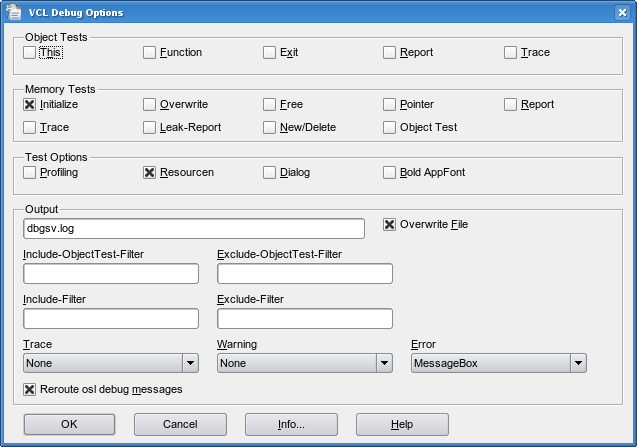Difference between revisions of "Non Product Build"
(moved some bits from Debugging) |
(adjusted to the OOo->AOO transfer) |
||
| Line 1: | Line 1: | ||
A so-called '''Non-Product Build''' of [[OpenOffice.org]] is one that contains a lot of additional diagnostics and [[Debugging|debug]] code, which is available in this special mode only. Such a build is usually larger and slower than an ordinary Product Build (which basically means: every build you ever downloaded from OpenOffice.org), but is very useful for developers. | A so-called '''Non-Product Build''' of [[OpenOffice.org]] is one that contains a lot of additional diagnostics and [[Debugging|debug]] code, which is available in this special mode only. Such a build is usually larger and slower than an ordinary Product Build (which basically means: every build you ever downloaded from OpenOffice.org), but is very useful for developers. | ||
| − | + | By default a Product Build is created, i.e. it is ready for release after completion. Non-Product Builds are created using the <code>--enable-dbgutil</code> switch during <code>configure</code>, which makes creation a non-product build simple. Raised assertions, and the debug options window lets you control your level of annoyance. | |
| − | + | ||
| − | By default | + | |
The most visible feature of Non-Product Builds are so-called assertions - Basically message boxes popping up, and saying that something went not the way the developer expected it to go. Such assertions are considered bugs, and as such should be [http://qa.openoffice.org/issue_handling/pre_submission.html reported in IssueZilla], with the summary starting with "ASSERT:" or "ERROR:" (since ERROR: is used by most of the assertion message boxes themself). | The most visible feature of Non-Product Builds are so-called assertions - Basically message boxes popping up, and saying that something went not the way the developer expected it to go. Such assertions are considered bugs, and as such should be [http://qa.openoffice.org/issue_handling/pre_submission.html reported in IssueZilla], with the summary starting with "ASSERT:" or "ERROR:" (since ERROR: is used by most of the assertion message boxes themself). | ||
| − | To use (or do QA for) the additional debug features: just run | + | To use (or do QA for) the additional debug features: just run AOO, and when it's in full-flow, press <Alt>-<Shift>-<Control> 'D' in that order; this should popup a debugging options window: |
| Line 13: | Line 11: | ||
| − | The debugging options are subsequently saved to the .dbgsv.ini file for the next run (you can control the location of that with e.g. <code>export DBGSV_INIT=$(HOME)/.dbgsv.init</code>) | + | The debugging options are subsequently saved to the .dbgsv.ini file for the next run (you can control the location of that with e.g. <code>export DBGSV_INIT=$(HOME)/.dbgsv.init</code>). |
Try the help integrated into the debugging options window to see what features it offers. | Try the help integrated into the debugging options window to see what features it offers. | ||
For available tools in non-product builds, have a look at the various <code>DBG_foo</code> macros in <code>tools/debug.hxx</code>, or, if you already are knowledgeable about this, let others participate by writing your knowledge down here. | For available tools in non-product builds, have a look at the various <code>DBG_foo</code> macros in <code>tools/debug.hxx</code>, or, if you already are knowledgeable about this, let others participate by writing your knowledge down here. | ||
| − | |||
[[Category:Build_System]] | [[Category:Build_System]] | ||
[[Category:Debugging]] | [[Category:Debugging]] | ||
Revision as of 10:45, 14 February 2013
A so-called Non-Product Build of OpenOffice.org is one that contains a lot of additional diagnostics and debug code, which is available in this special mode only. Such a build is usually larger and slower than an ordinary Product Build (which basically means: every build you ever downloaded from OpenOffice.org), but is very useful for developers.
By default a Product Build is created, i.e. it is ready for release after completion. Non-Product Builds are created using the --enable-dbgutil switch during configure, which makes creation a non-product build simple. Raised assertions, and the debug options window lets you control your level of annoyance.
The most visible feature of Non-Product Builds are so-called assertions - Basically message boxes popping up, and saying that something went not the way the developer expected it to go. Such assertions are considered bugs, and as such should be reported in IssueZilla, with the summary starting with "ASSERT:" or "ERROR:" (since ERROR: is used by most of the assertion message boxes themself).
To use (or do QA for) the additional debug features: just run AOO, and when it's in full-flow, press <Alt>-<Shift>-<Control> 'D' in that order; this should popup a debugging options window:
The debugging options are subsequently saved to the .dbgsv.ini file for the next run (you can control the location of that with e.g. export DBGSV_INIT=$(HOME)/.dbgsv.init).
Try the help integrated into the debugging options window to see what features it offers.
For available tools in non-product builds, have a look at the various DBG_foo macros in tools/debug.hxx, or, if you already are knowledgeable about this, let others participate by writing your knowledge down here.
